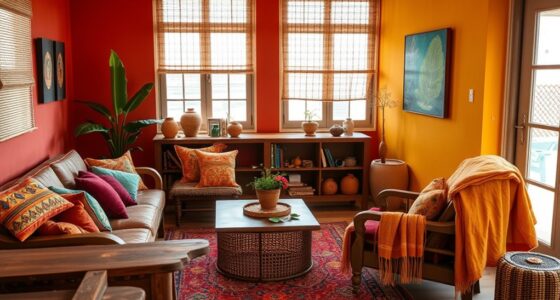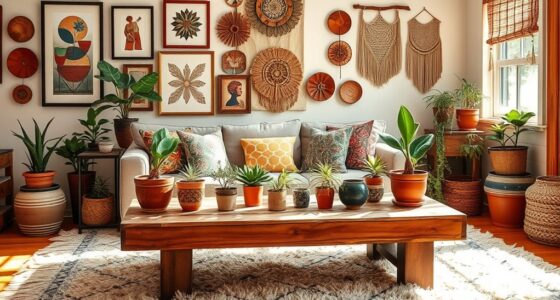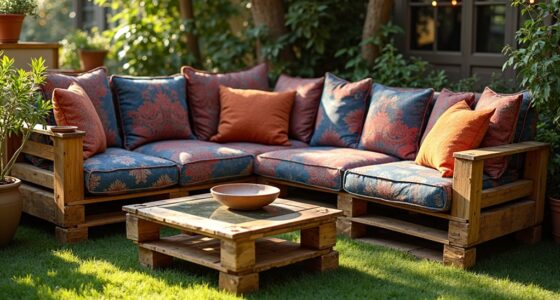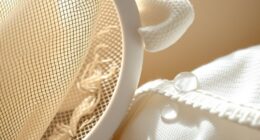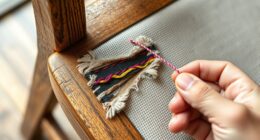To create a DIY headboard with textiles like kilim rugs, cane, and rattan, start by choosing a sturdy frame, perhaps from reclaimed wood. Stretch vibrant textiles tightly over the frame, securing them with a staple gun for a clean look. Add natural touches like cane or rattan inserts for texture and warmth, or attach wooden accents for rustic charm. Focusing on details guarantees a polished finish. Keep exploring to discover step-by-step tips for a striking, personalized headboard.
Key Takeaways
- Choose bold textiles like kilim rugs or woven cane for vibrant, textured headboards that serve as statement pieces.
- Measure your bed and desired headboard height to create a custom size that fits perfectly.
- Use reclaimed wood frames for rustic charm, attaching textiles tightly and securely for a polished finish.
- Incorporate wooden accents, slats, or shelves into the headboard design for added functionality and visual interest.
- Layer different textiles and details like trim or piping to enhance texture, depth, and a personalized, eco-friendly style.
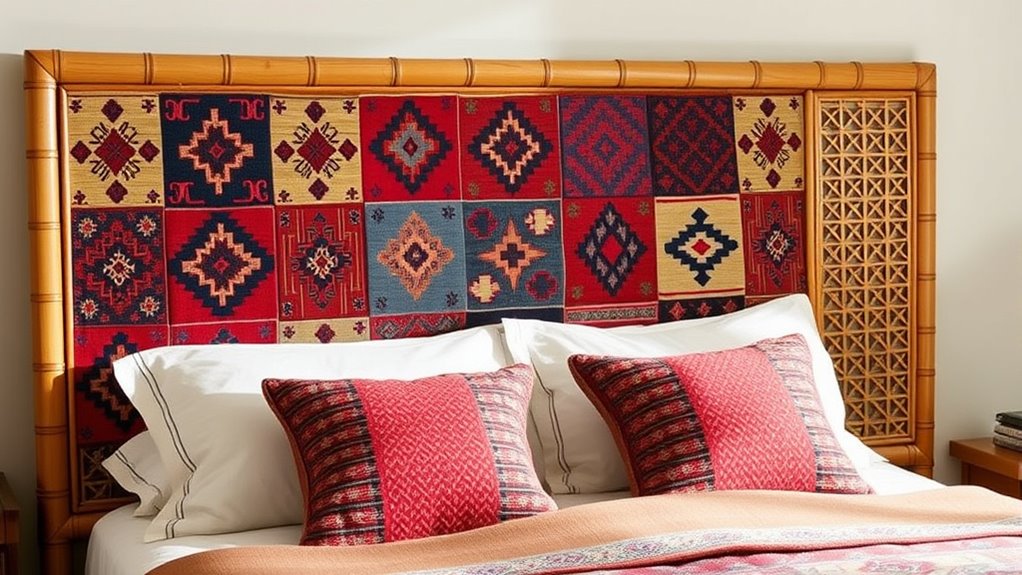
Ever wondered how to transform your bedroom with a simple, budget-friendly project? Creating a DIY headboard with textiles is an excellent way to add personality and style without breaking the bank. Whether you prefer the softness of upholstered headboards or the rustic charm of reclaimed wood accents combined with fabric, this project is flexible and rewarding. You can craft a headboard that reflects your personality while keeping costs low, all by repurposing materials and engaging your creativity.
Start by choosing your fabric. Kilim rugs, with their bold geometric patterns, instantly bring color and texture, making them perfect for a statement piece. Cane and rattan are fantastic choices if you’re after a more natural, airy look. These materials work well with reclaimed wood accents to create a balanced, eclectic vibe. Once you’ve selected your fabric, measure your bed’s width and decide on the height you want your headboard to be. Keep in mind that a taller headboard can serve as a focal point, especially if it features intricate textile patterns.
Choose bold textiles like kilim rugs or natural materials such as cane and rattan for a unique headboard focal point.
If you’re leaning toward an upholstered headboard, you’ll need a sturdy frame. You can repurpose an old wooden frame or build one using reclaimed wood for a more rustic finish. To attach the textile, stretch the fabric tightly over the frame and secure it at the back with a staple gun. For a cleaner look, you might add a border of trim or piping. If you prefer a more textured approach, consider layering textiles—like placing a kilim rug over a plain fabric or combining rattan elements with fabric upholstery for added depth.
For a more natural touch, incorporate reclaimed wood accents into your design. For example, attach strips of reclaimed wood along the edges of the headboard or create a slatted design that allows the textile to peek through. This combination of textiles and reclaimed wood creates a warm, inviting aesthetic that suits both modern and vintage interiors. You can also embed small wooden shelves or hooks into the design, blending functionality with style.
Additionally, choosing natural materials such as wool, cotton, or linen can enhance the tactile experience and support the eco-friendly aspect of Waldorf-inspired design. No matter which style you choose, remember that the key to a successful DIY headboard is attention to detail. Make sure your textiles are stretched evenly and securely fastened, and take the time to sand and treat reclaimed wood accents for a polished look. With just a few supplies and some effort, you’ll have a custom headboard that enhances your bedroom’s decor, showcases your personal taste, and proves that a little creativity goes a long way.
Frequently Asked Questions
How Do I Choose the Right Textile for My Headboard?
To choose the right textile for your headboard, consider fabric durability to guarantee it withstands daily use. Think about your room’s style; pick a pattern or color that complements your decor. If you want a cozy feel, go for plush or textured fabrics. For a sleek, modern look, opt for smooth, shiny textiles. Balancing durability with style coordination helps you select the perfect fabric for your headboard.
Can I Use These Headboards Outdoors Safely?
You can use these headboards outdoors, but only if you prioritize weather resistance and mold prevention. Kilim, cane, and rattan add charm, yet they’re vulnerable to moisture and sun damage. Treat your textiles with sealants or choose specially designed outdoor fabrics to defend against mold and weather elements. Regular maintenance ensures your headboard stays vibrant and durable, turning a simple outdoor space into a cozy retreat.
What Tools Are Needed to Assemble These Headboards?
To assemble your headboard, you’ll need a drill, screwdriver, measuring tape, scissors, and possibly a staple gun. Focus on attachment methods suited for fabric durability, like secure staples or strong screws, to guarantee your headboard stays intact. Using the right tools helps you tightly attach textiles to the frame, preventing wear and tear over time. Make sure you select tools that match your materials for a sturdy, long-lasting headboard.
How Do I Clean and Maintain Textile Headboards?
To keep your textile headboard looking fresh, you should regularly vacuum it using a soft brush attachment to preserve the fabric. For stain removal, act quickly with gentle techniques like blotting with a damp cloth and mild detergent. Avoid harsh chemicals to protect the fabric’s integrity. Regularly check for dust and dirt, and consider professional cleaning for deep maintenance, ensuring your headboard stays beautiful and well-preserved over time.
Are These Headboards Suitable for All Bed Sizes?
These textile headboards are generally suitable for most bed sizes, but you should check the specific dimensions to guarantee compatibility. When choosing your textile options, consider the size of your bed—larger beds need broader or more substantial headboards, while smaller beds can work with more delicate designs. Always measure your space and select a textile that complements your bed size for a perfect fit and aesthetic balance.
Conclusion
Creating your own textile headboard is a rewarding way to personalize your space. With DIY projects like kilim, cane, or rattan, you not only add style but also save money—did you know that DIY home upgrades can save up to 20% compared to hiring professionals? So, get creative and enjoy the process of transforming your bedroom into a cozy, unique retreat. Your perfect headboard is just a project away!


